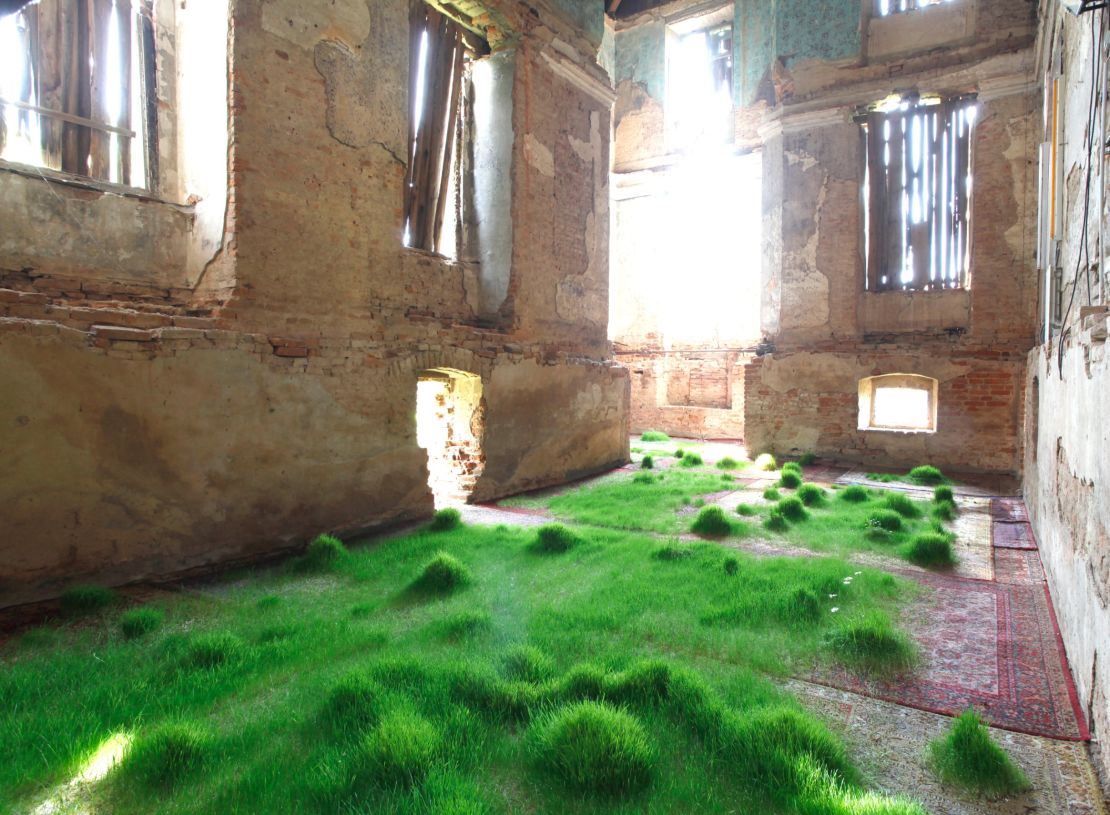The home and the garden become one in “untitled (Persian Rugs) 2016” Martin Roth’s latest installation at the Korean Cultural Centre in London, where he’s brought a number of ancient Persian carpets to life through the cultivation of grass.
It’s not the first time Roth has incorporated the natural world into his work. Previously, the Austrian-born, New York-based artist has has filled a New York gallery with Syrian rubble and parakeets; used a Donald Judd sculpture as a snail habitat; flooded an Austrian gallery; released a goldfish into the Chinese Garden Court at the Metropolitan Museum of Art; and, in July 2012, lived among sheep in the European countryside, saying “it functioned as a rupture of our 24/7, always-on, always-connected, high performance culture.”
Roth utilizes living organisms “as a stand in for humans – to show that we’re also characters caught in conditions where we don’t have control.”
He spoke to CNN Style about working with living organisms and changing our perceptions of reality.
Why have you always used organic matter in your work?
My main interest is this idea that something is constantly changing. I started working with organic matter because it ensured the installation was different each time you saw it.
Where did the idea of using Persian carpets in an installation come from?
Carpets were originally reproductions of gardens, and I love the idea that rugs are basically gardens that can move across space.
The idea came out of having this object that is a representation of nature, and thinking ‘How can I make this real?’ By planting a lawn indoors, I am playing with the notion that nature has already been domesticated. A lawn has become a poor substitute for nature, but at the same time grass also stands for life – it’s a resilient survivor in an urban jungle.

Was it difficult logistically?
It really was an experiment, I didn’t know if it would work. At first I wondered how I could place soil underneath or on top, but when we tried it out in the studio suddenly the grass grew without soil. This made it much more interesting for me, as suddenly it was an almost utopic gesture. I was creating this beautiful, lush, green garden on top of this dark red Persian carpet that ultimately could not survive. It would always be ephemeral; it would at one point just disappear.
Does the object itself – in this case the Persian carpet – have any significance?
It has this political and cultural meaning, as it’s a beautiful, handmade cultural icon. By creating something new from this piece, in a sense I’m destroying a cultural item.

Do you encounter any problems working with such unpredictable materials?
It’s part of the work. An artist is usually in control of his or her work – you’re the master over your painting, you step back, you add another brush stroke et cetera – but with my work, I just put things in motion. I put the seeds on the carpet, but where and how the grass grows is out of my control. This is really important – there’s this sense that it’s always changing, but also that it’s living on its own. As the artist, I’m almost secondary. I set it up and then the work creates itself.
Do you view your work as philosophical?
I would love to. I hope to. It’s not just what it is. I see a lot of work where a plant or an animal is used like a prop, and I know that’s not my work.
By giving agency to animals and plants, by viewing them as collaborators, I hope to raise philosophical questions in the viewer. I don’t believe in the existence of a single world in which all living creatures share the same time and space, and with my work, I hope to draw attention to the simultaneous familiarity and strangeness, and closeness and alienation, between us humans and the world at large.
Koo Jeong A: Riptide, Korean Cultural Centre UK, London, 7 October – 19 November 2016












